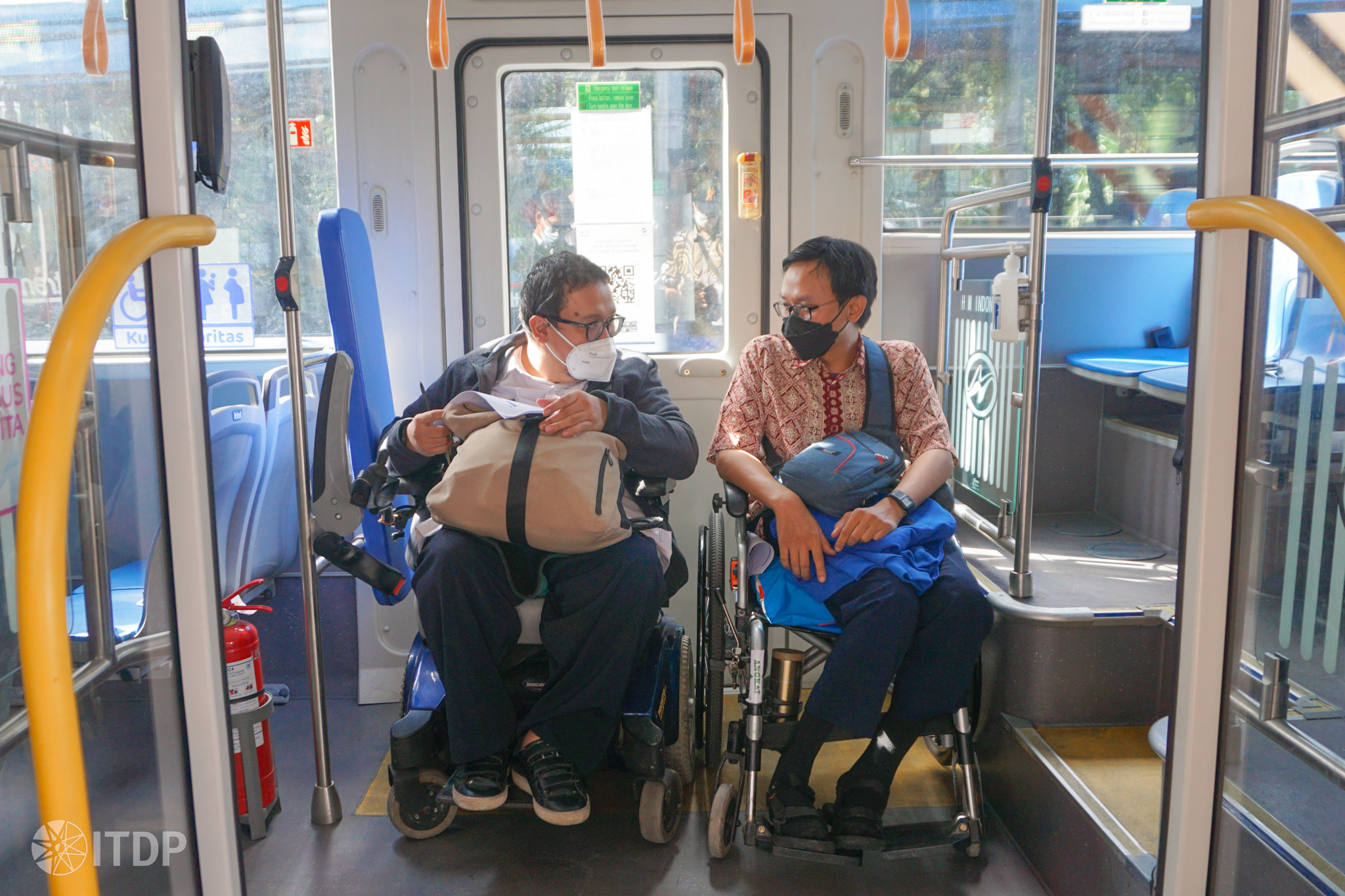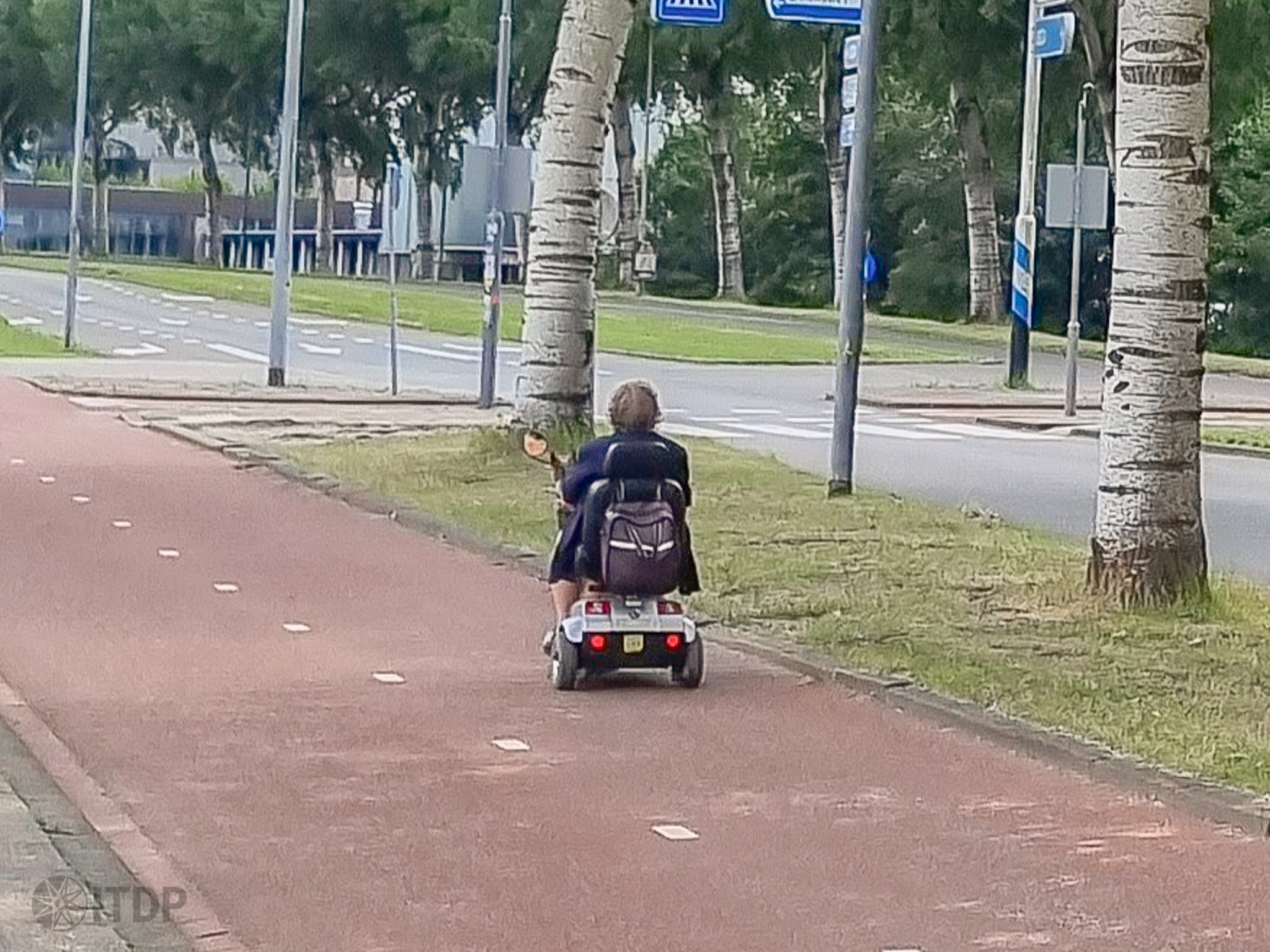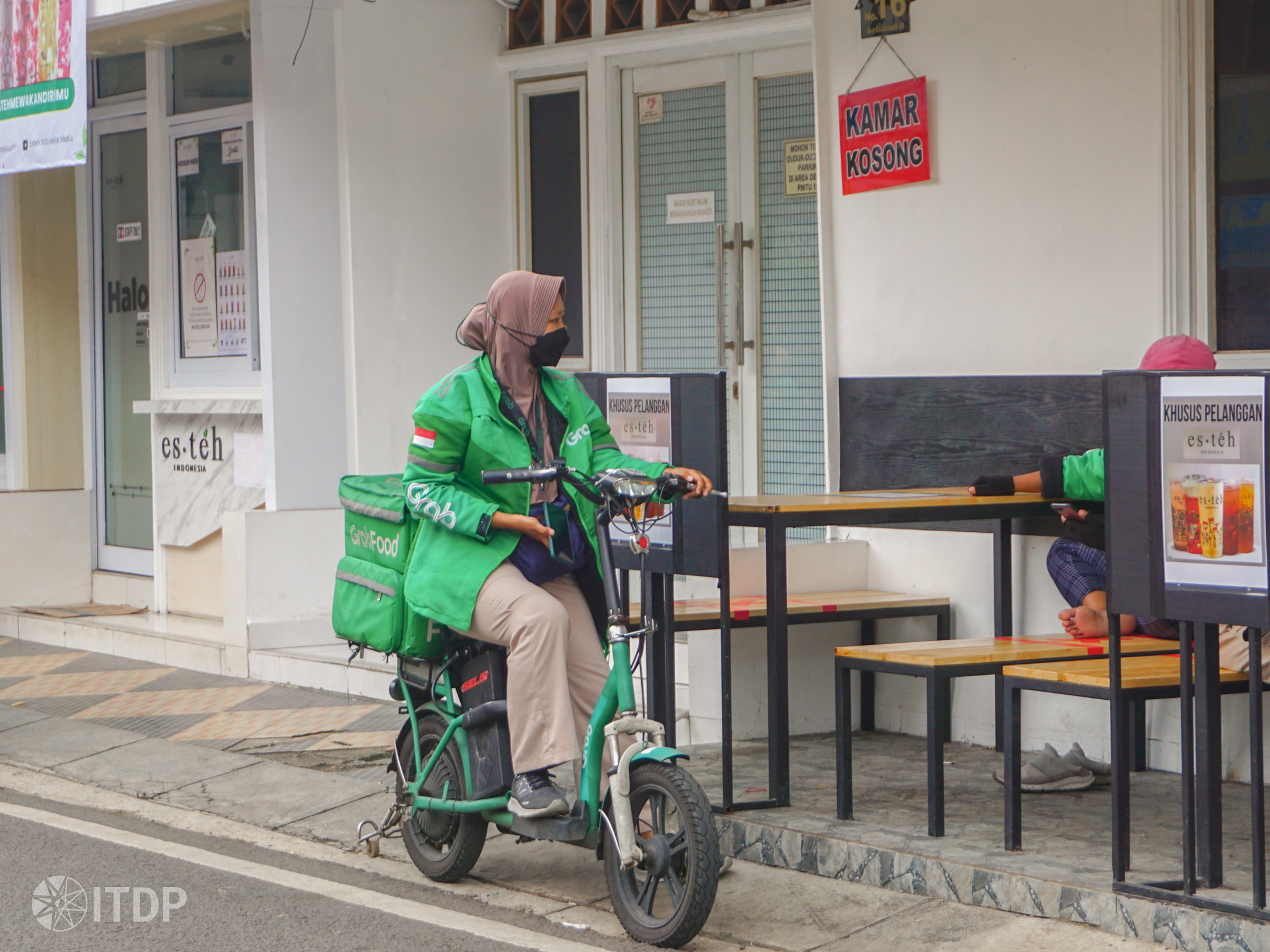July 25, 2023
Embracing Inclusivity in Electrification
Writer: Deliani Siregar, Sr. Urban Planning and Social Inclusion Associate
Baca artikel dalam versi Bahasa Indonesia di sini.

In debates related to electrification issues, public transportation, and private motorized vehicles are often clashed regarding which one should be prioritized first. Based on the results of ITDP Indonesia’s studies over the past two years related to the electrification of road-based public transportation, buses, microbuses or angkot as well as motorized 2 and 3 wheelers, if it is planned in the GEDSI perspective, both will have great potential and impact, both in efforts to reduce transportation emissions and increase accessibility for vulnerable groups in the city.
Gender Equality, Disability, and Social Inclusion (GEDSI) is an important topic in transportation because users of both active transport and public transportation are dominated by vulnerable groups. In Indonesia, vulnerable groups can be defined as women, children, older persons, people with disabilities, and indigenous people following the National Action Plan for Human Rights (RAN HAM) 2021-2025. In particular, vulnerable groups in urban transportation can be defined as women, children, people with disabilities, and the older persons (Sustainable Development Goals (SDGs) point 11.2).
Based on the results of ITDP’s assistance in 27 urban neighborhood in Jakarta in 2018-2020, it is known that adult women and children prefer to walk and use microbuses or angkot for mobility. Women and children also use and choose rickshaws for mobility with goods. Based on the results of the Global Future Cities Program (GFCP) survey in 2020 in Bandung, public transportation such as microbuses was chosen by female respondents because of its affordable price and served routes. Adult women do not widely choose motorcycles as a mobility option in the neighborhood because in every household, motorcycles, as either the first or second vehicle, are given to adult men (or fathers, as the main family breadwinner) and/or their children.

Bus Electrification: Fleet Repair and Upgrade Opportunity
Large-scale electrification of road-based public transport (buses and microbuses) significantly reduces transport emissions in cities due to the high number of kilometres travelled and exhaust gases emitted. In the case of Jakarta, city buses contribute 45.7% and 21.4% of air pollution CO2 emissions in Jakarta, respectively. With the electrification of Transjakarta buses, an estimated GHG reduction of 611,580 tCO2eq in total is expected by 2030. More importantly, buses and microbuses are more accessible to vulnerable groups who do not have the skills or opportunity to use private motorized vehicles, namely women, older persons, and children. The momentum of bus and microbuses electrification can be utilized to update the interiors of the bus and microbuses fleet, which many diesel buses note, to improve access for vulnerable groups. For example, the minimum manoeuvring space required from the door to the wheelchair space on the bus, the number of wheelchair spaces available, the availability of luggage space, and other notes. The involvement of vulnerable groups is critical in the planning process.
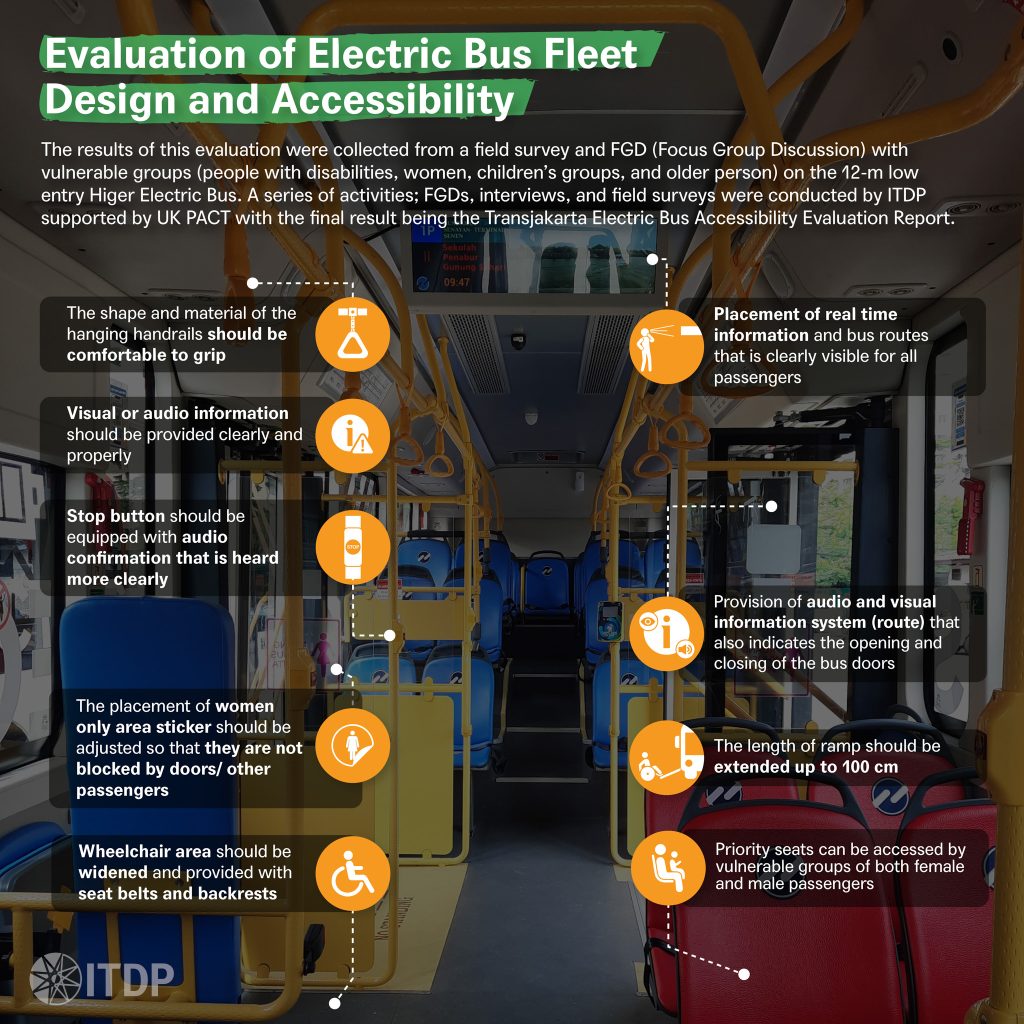
From a broader perspective, the electrification process of public transportation, such as for buses and microbuses, workers, and operators of existing public transport in cities are also categorized as vulnerable groups. Taking an example from the electrification process of Transjakarta, it shows that public transportation operators, including drivers and other support staff, are ready to participate in the all electrification process, starting from the operation and maintenance of vehicles to the selection of priority routes to be converted, which is undoubtedly different from ordinary diesel buses. The bus electrification funding scheme also needs to consider the participation of vulnerable groups to avoid social exclusion. For example, when the transition to electric buses occurs, it turns out that existing bus operators are not financially able to buy electric buses, causing the family economy to suffer. This may happen because, currently, bus procurement or the purchase of electric buses is still charged to the bus operators. In ITDP’s study on a training needs assessment conducted on female and male trolleybus drivers, it was identified that the skills of female drivers in driving trolleybuses, planning trolleybus routes, and preventive measures for damage mitigation and vehicle maintenance are lower than male drivers. Therefore, training is needed for female drivers to help them easily adapt to the transition of electric buses and their ecosystems, including on how to charge electric bus vehicles, mitigate in the urgent matters and hazard such as a flood disaster, and mitigate a situation when the bus is running out of battery in the middle of service time. The existence of this training program is expected to ensure that female drivers of conventional buses can continue to work and survive in the Transjakarta electric bus system. Because in 2021, there are 23 people (4% of total employees), total Transjakarta female drivers, and 3 people are electric bus drivers (2022).
Electrification of Motorized 2 and 3 Wheelers: Helping Women and People with Disabilities Mobility
The ITDP survey results in 27 Jakarta urban neighborhood also found out motorcycles as the highest mode choice used by three groups; adult men, adult women, and children. Motorcycles are perceived by women and children as a choice of transport mode which can be used together with the whole family members (sharing). This is similar to the results of a research conducted by Herwangi et al., 2015 which states that low-income community groups in the Yogyakarta Urban Area have a dependence on motorbikes due to its easy and cheap access to be obtained, its flexibility as an economic mode, and the absence of reliable public transportation availability. It is also known that each house holds in the study area owns more than one motorbikes. Looking at these data, motorcycles are still a challenge for sustainable transportation.
Electrification can be a momentum to convert motorized 2 and 3 wheelers into more environmentally friendly vehicles. In addition, electrification of motorized 2 and 3 wheelers accompanied by changes in infrastructure to support regulations and policies using the perspective of vulnerable groups can generate inclusive economic opportunities for road safety.
Along with the electrification of public transportation, the electrification of motorized 2 and 3 wheelers, such as bicycles, motorcycles, tricycles, motorized rickshaws, and bajaj, may also occur to match the mode preference of the current society. Despite their limited carrying capacity, these modes offer flexibility and a potency to be used as economic tools. By electrifying these modes, it provides environmental and road safety impacts, as well as opportunities for more sustainable economic participation. For example, the electrification process of rickshaws can increase the efficiency and effectiveness aspects in earning a living. Switching to electric pedicabs can be an option and opportunity for vulnerable groups, the pedicab community, to more easily carry goods on a larger scale and over longer distances which, of course, is also linear with the possibility of wages earned.
This electrification momentum may be used to encourage the shift from motorcycles to electric bicycles, especially for short trips. In the Yogyakarta Urban Area, for example, it is known that the average daily travel distance by motorcycle for school and work is 2.5-3.0 km per trip (Herwangi. Syabri, and Kustiwan, 2015). This distance is suitable for conversion to cycling, as the ITDP (2021) survey results show that the average distance for regular cycling is 2.89 km. In the Netherlands, electric bicycle commuting replaces pedal bicycles and motorcycles with 1.5 times the distance compared to pedal bicycles.
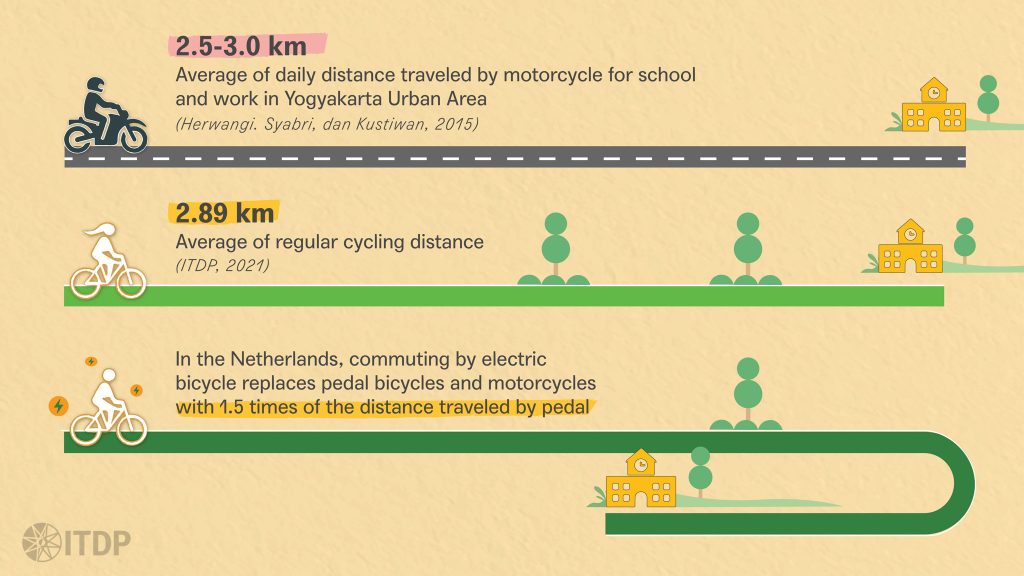
For people with disabilities, specifically Deaf people, electric bicycles can be an option for economic means to replace motorcycles. This addresses the issue of the need for a driver’s license to drive a motorcycle, while a bicycle does not. In addition, electric bicycle vehicles are also developing with designs aimed at elderly mobility, for example, three- or four-wheeled electric bicycles.
The development of electric bicycles in Indonesia occurs in many medium-sized cities, with women as the target market. The use of electric bicycles is quite widespread in urban residential areas. Electric bicycles are currently on the market, and most in-demand are electric bicycles with feminine designs (Sodiq and Tristiyono, 2015). According to Sodiq and Tristiyono (2015), these electric bicycles are generally used by housewives for several primary purposes, such as shopping, taking children to school, visiting neighbours, and cycling around the residential area. Aside from the fact that electric bicycles can cover longer distances in a relatively shorter time than pedal bicycles, by improving the design of electric bicycles and developing clear regulations for electric bicycles, electric bicycles are considered to be able to replace motorbikes as a mode of choice for women.
From GEDSI’s perspective, the electrification of online ride-hailing can open up jobs for women and people with disabilities. Although there are many notes related to the scheme of partnerships, between the driver and operator, there is an increasing trend in female drivers in online ride-hailing services. From the ITDP study in 2022, with the electrification of online ride-hailing, there is a potential increase of up to 224.8% of female drivers with the role of a single parent or head of the family in 2030. This is because women prefer electric motorcycles over conventional motorcycles and prefer taking food delivery orders rather than people/goods delivery services. From the same study, ITDP concludes that these benefits can only occur if online ride-hailing companies offer a rental system for vehicles and/or electric motorcycle batteries, eliminating the need to own their vehicles and the need to organize road safety training programs and electric vehicle repairs for women and disabled drivers.
(Only) Electrification Is Not Enough
Although electrification involving the GEDSI perspective is organized in the future, it will be a big task without other efforts supporting short-distance travel within the city. Electrification can have the maximum impact in reducing GHG emissions if accompanied by other efforts, such as the availability of decent and affordable housing in urban homes and the structuring of areas based on walking, cycling, and public transportation. If these are not done, it will still result in the same outcomes; congestion, air pollution, and limited land use in the city.

